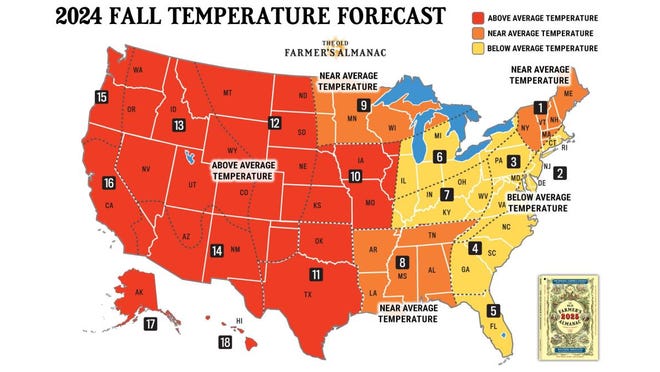For those eagerly awaiting trips to apple orchards and pumpkin patches this fall, don’t forget to pack a sweater as temperatures are expected to be cooler than normal, according to the Old Farmer’s Almanac.
The journal released its annual fall forecast, which predicts below-average temperatures for residents of North Jersey, while above-normal temperatures are expected in most states in the West, including Hawaii and even Alaska.
New Jersey appears to be divided into three parts when it comes to rainfall forecasts, with average rainfall forecast for much of the state. Below-average rainfall is expected in Sussex County, and a small portion of Warren County is represented by a small red dot on the almanac map, indicating that above-average rainfall is possible in that area.
If the forecast holds true, areas with below-average temperatures and rainfall could see a range of beautiful fall foliage, including in Northeastern states, the almanac said.
What are the average fall temperatures in Northern New Jersey?
Here are the average monthly temperatures in fall collected by the Office of the National Climatologist at Rutgers University over 128 years, from 1895 to 2023:
- September: 65.5 degrees
- October: 54.4 degrees
- November: 43.6 degrees
- December: 33.7 degrees

What does this mean for fall foliage?
New York's Adirondacks and Catskill Mountains and Pennsylvania's Poconos are among the Almanac's best places to experience vibrant fall foliage, although North Jersey also has plenty of beautiful red, orange, and yellow foliage .
In fact, animated maps predicting foliage progression show foliage really starting to turn in late September, peaking in much of north and central Jersey during the first week of October, and exceeding the peak in late October and early November.
The almanac predicts that much of New England will be at or near peak fall color as early as October 11, a deviation from the usual peak in mid-to-late October. Weather and where you live will be a factor.
What is the average fall rainfall in North Jersey?
While much of the country will see below-average precipitation, New Jersey's precipitation amounts will be mixed with the almanac forecast.
Here are average fall monthly rainfalls collected again over the past 128 years by the Office of the State Climatologist at Rutgers University:
- September: 3.79 inches
- October: 3.57 inches
- November: 3.40 inches
- December: 3.80 inches

How accurate is the Old Farmer's Almanac?
North America's oldest continuously published periodical, founded in 1792 when George Washington was president, has an overall accuracy rate of 80% in weather forecasts.
Their overall accuracy rate for the 2023-2024 winter forecast was 64%, a sharp departure from their standards, which they attributed to “recent unusual weather patterns.” According to the journal, the accuracy of precipitation estimates is about 83%, and the accuracy of temperature estimates is about 44%. The almanac's forecast of above-normal temperatures was spot on along the East Coast, especially in New Jersey, where the weather was wet and warm. The journal even determined when the region's first snowstorm occurred during the second week of January.
The almanac claims to use a “secret formula” to derive its weather forecasts, relying heavily on solar activity and patterns, meteorology and atmospheric science, as well as historical trends and average temperatures.
For years, experts in meteorology and atmospheric research have criticized the Almanac's forecasts, often telling readers to take them with a grain of salt. A University of Illinois study compared almanac forecasts to five years of actual weather data and concluded that they were only about 52 percent accurate.
But the Almanac also had its supporters, and the Illinois study still called the journal a “remarkable piece of American history” filled with planting advice and fun, factual articles that had “something for everyone.” The journal even boasted in press materials that its prediction of 2015's “bitterly cold winter” was 96% accurate.
From an easy-to-read gardener's guide to growing plants, to planetary events, and even some jokes or fun facts about animals, it's no surprise that this centuries-old publication remains in high demand. The book has 1.7 million fans on Facebook, up from 1.3 million since 2016.
Email: lcomstock@njherald.com; Twitter: @LoriComstockNJH or Facebook.
